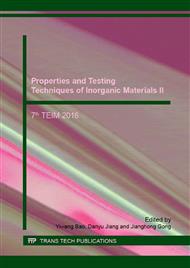p.255
p.261
p.266
p.271
p.276
p.282
p.287
p.292
p.297
Measurement and Characterization of CeO2-TiO2 Ion Storage Films for Electrochromic Devices
Abstract:
CeO2-TiO2 sols and films were prepared by sol-gel method. The precursor sols consist of a mixture of cerium nitrate hexahydrate Ce(NO3)3·6H2O, butyl titanate Ti(OC4H9)4 and anhydrous ethanol CH3CH2OH. The films were deposited using the dip-coating technique and calcined at 310 °C in an oxygen atmosphere. The effects of the molar ratios of cerium to titanium(0.55:1, 0.70:1, 0.85:1, 1:1)on the microstructure and properties of (CeO2)x-TiO2 films were investigated. The surface morphology, electrochemical performance and optical property were characterized by FE-SEM, cyclic voltammetry (CV) and UV-Visible spectrometer, respectively. The results show that the properties of the films are tightly related to cerium to titanium ratio. When the molar ratio of cerium to titanium is 0.85:1, the ion storage capacity value of CeO2-TiO2 film is 19.99mC/cm2, whereas the pure TiO2 film is 11.52mC/cm2. The stability tests and optical measurements confirm that the developed CeO2-TiO2 films can be use as ion storage-counter eletrodes in electrochromic devices.
Info:
Periodical:
Pages:
276-281
Citation:
Online since:
January 2017
Authors:
Keywords:
Price:
Сopyright:
© 2017 Trans Tech Publications Ltd. All Rights Reserved
Share:
Citation:


